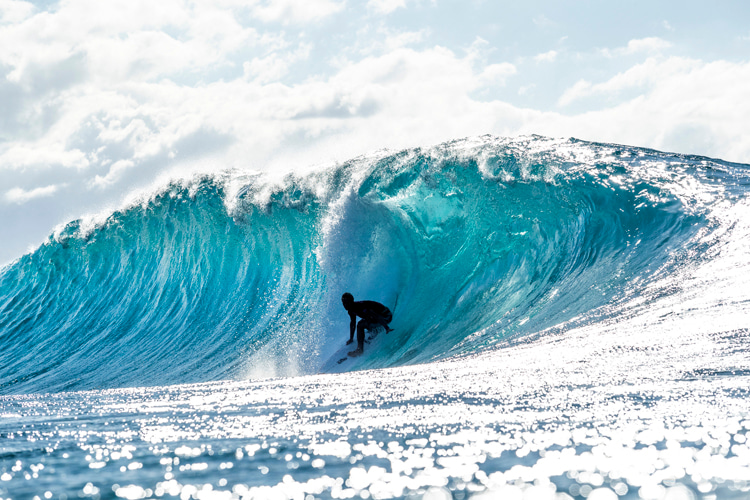Welcome to the surfing world's most famous coastline. Discover the complete list of waves and surf breaks on Hawaii's North Shore of Oahu.
Only 24 miles (38.7 kilometers) separate Turtle Beach from Ka'ena Point on the island of "Town and Country" (North Shore and South Shore).
According to Google Maps, if you'd walk nine hours from east to west, you'd be able to see all the surf spots that make the North Shore the iconic stretch of coastline that it is today.
What's really fascinating about the northern side of Oahu is that nearly every yard of shore provides a rideable wave, particularly between October and April.
They could be more or less exposed to the North Pacific swells, hidden in coves and bays, or sheltered by sandy beaches and rock formations, but there's always water energy running toward the island.
The North Shore of Oahu is a sacred sanctuary with a rich past that will always have a special and dedicated chapter in surf history books.
Like any sought-after resource, it's also a place for tension, disputes, competitiveness, and territorialism.
In the race for gold, only a few will prevail in surfing's birthplace.
But the North Shore of Oahu and its waves are always there, glorious and imperial, supreme and tameless, as the best surfing arena Nature has ever shaped.
And if you're really into checking the crème de la crème, we extend the red carpet so that you appreciate the elite of the Hawaiian gems named Seven Mile Miracle.
Now, from east to west, take a ride along Kamehameha Highway and make sure to stop at The Gathering Place's most famous surf spots, blessed by magically placed reefs.
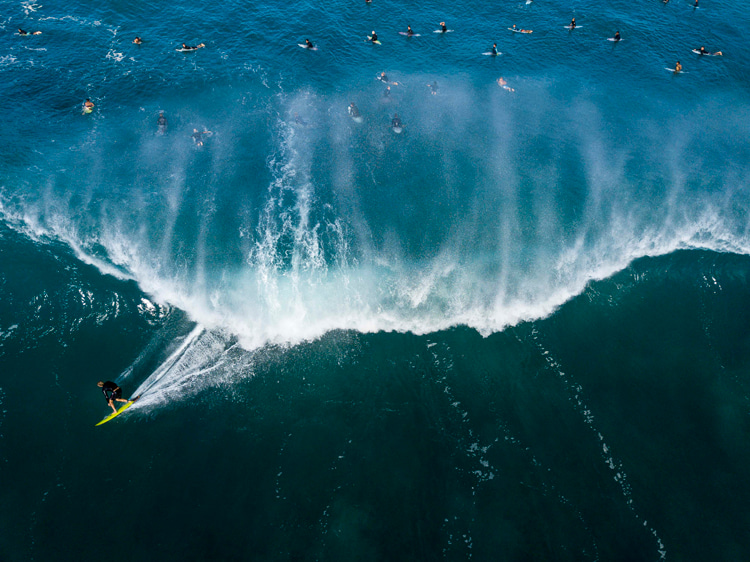
Velzyland
Velzyland, also known as V-Land, was named after surfboard shaper Dale Velzy, who first surfed the break in the 1950s.
It's a small right-hand wave that works well in the 2-8-foot range and can peel for 150 yards.
It breaks on a shallow coral bottom and can be heavily crowded. It works best on low to medium tide with NW swells.
It has two main take-off areas plus an extra zone on the left side.
Backyards
Backyards is a shifty wave that challenges you to take off fast to get covered for a while.
You will need to observe before you go and choose your waves really well. Some of them might look good and then detonate over the shallow coral.
The spot is located in the backyard of beachfront houses and connects with its neighbors, Sunset Beach and Boneyards.
It works best when it's overhead or double overhead, with NW swells and from low to medium tide. Mind the rips through the channel.
On windy days, expect a fleet of windsurfers invading the lineup.
Sunset Beach
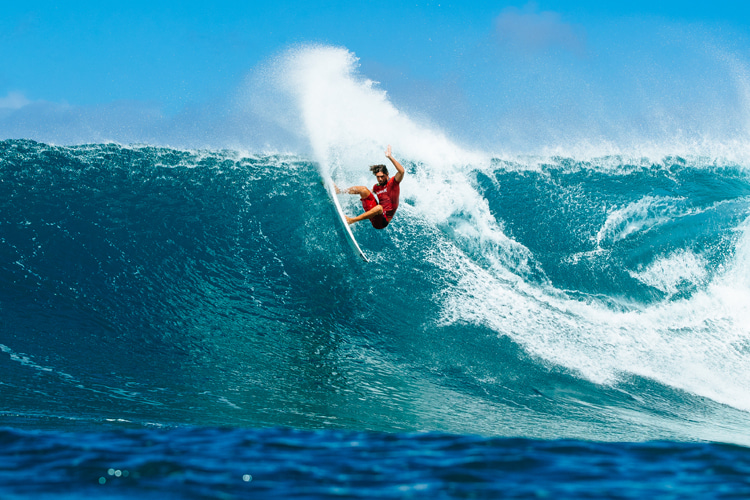
Sunset Beach, originally known as the Sunset Tract, was a name a real estate developer gave to the area in the 1920s to sell properties overlooking a paradise at the end of the day.
But for surfers, it's one of the most challenging waves on the planet and one of the three venues of the Triple Crown of Surfing.
On big swell days, the outer deep-water reef pumps massive walls of fast-moving water that can easily get to 30 feet.
The world-class surf break and its infamous West Peak provide a long right-hand wave with a steep take-off that provides a tube in the bowl zone.
Sunset Beach, with its strong offshore winds and rising peaks, will put an advanced surfer to the ropes of their existence once it gets past the triple overhead mark.
It works best with NW swells at any tide. Watch out for the dangerous rip currents, the locals, and the sneaky sets.
Kammieland
Kammieland is a fickle yet consistent and long wave breaking over a shallow reef.
The left-hander offers plenty of workable walls for intermediate and more experienced surfers. It is located across the former historic Kammie's Market, run by the Kam family.
It is usually less crowded than other North Shore surf spots but still has plenty of hungry riders. It shines with NW swells on low-to-medium tide.
Monster Munch
Monster Munch, also known as Monster Mush, is an A-frame wave with a predominantly better right-hander.
On small swell days, it could be an interesting option on a medium tide, especially with a northern pulse.
The steep drop precedes a fast-break tube section that will challenge any intermediate shortboarder.
On a tiny day, adventure yourself into the shallow coral break on a longboard.
Rocky Point
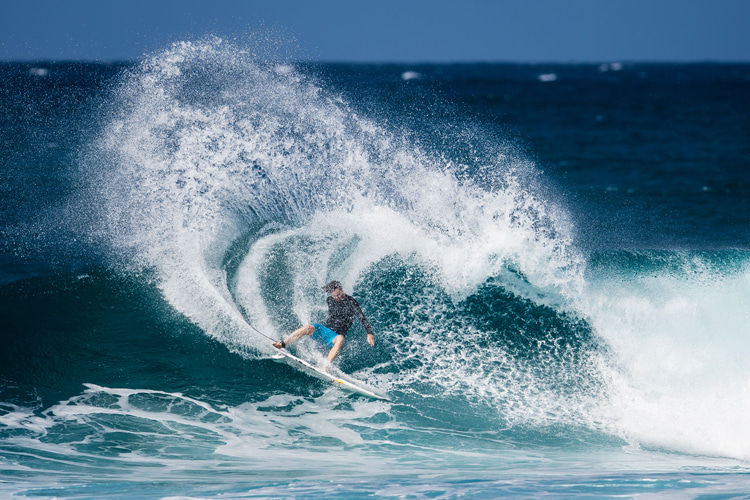
Rocky Point is a must-surf North Shore gem located halfway between Sunset Beach and Banzai Pipeline.
This freight train will take on a fast and hollow ride over hard rock structures before randomly deciding your fate in the shore break.
It's the perfect training ground for the all-around performer, delivering both high-end tube-time and open wave faces.
Nevertheless, it becomes unrideable above 12 feet. Dare to try it when it's chest-high, on low-to-medium tides, during NW swells.
Gas Chambers
Gas Chambers is a challenging and fast left and right-hand wave with plenty of barreling opportunities.
But before getting yourself pitted in the green room, you've got to master the brutal take-off without hitting the reef. Feel free to wear a helmet, especially on bigger days.
It's a great wave for putting your skills to the test. Surf it with NW swells and on low-to-mid tides.
Pupukea
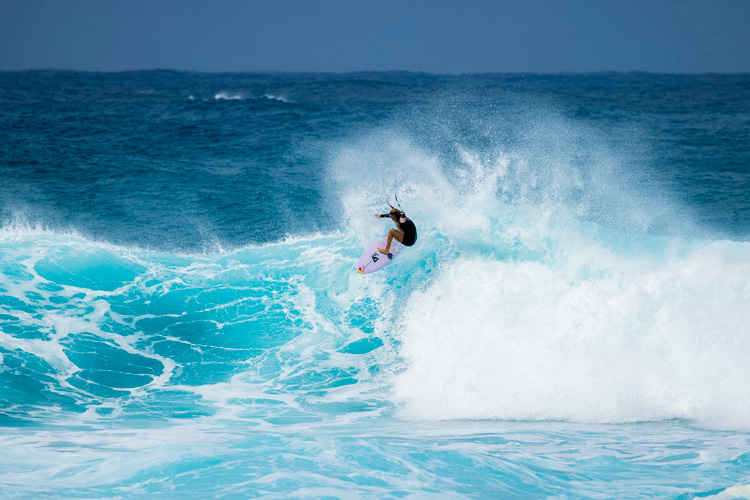
Pupukea is one of the sand and rock bottom surf breaks that populate Oahu here and there. It can be fun and safe until six feet, and demanding up to ten feet.
If you get hit by a thick lip, you'll feel its power; if you manage to get inside the barrel, it can be a mesmerizing experience.
The crescent-shaped, white sandy beach with puka shells makes this place the quintessential tropical paradise and a classic Hawaiian surf break, perfect for both beginner and advanced riders in corresponding conditions.
Banzai Pipeline
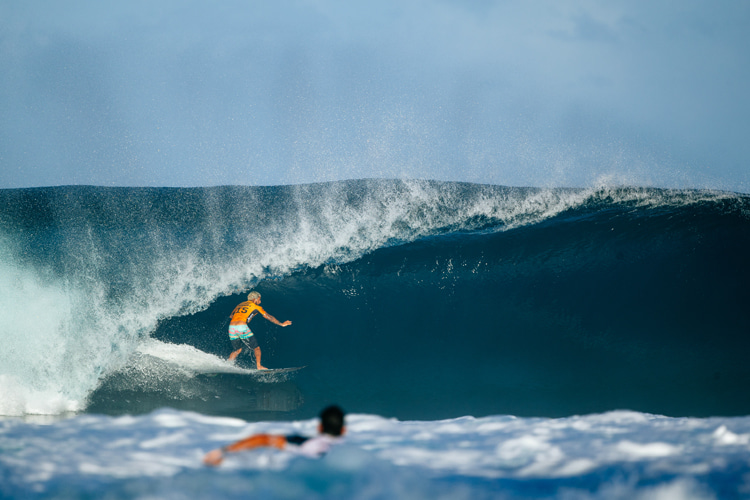
Pipeline is the wave of all waves.
It's the ultimate surfing arena and the break that incorporates everything a surfer is expected to master - the positioning, the reading of the incoming waves, the take-off and drop, and the rail game.
If you can make it out of the spray-spitting left-hand barrel, you're ready to take on almost anything.
A pipe breaks off 100 yards from the shore over a shallow coral reef.
Hawaii's crown jewel has claimed lives, and it is a nerve-wracking ultimatum even to the most experienced rider, especially when it's firing in the 12-15-foot range.
The ride might be short, but it's as intense as any life-threatening thing you could experience.
As Gerry Lopez once put it, "It's not a matter of whether you're going to get hurt surfing out there, but more a matter of when."
For epic sessions at the most documented wave on Earth, ride it with a light offshore breeze during pulsating NW swells.
Backdoor
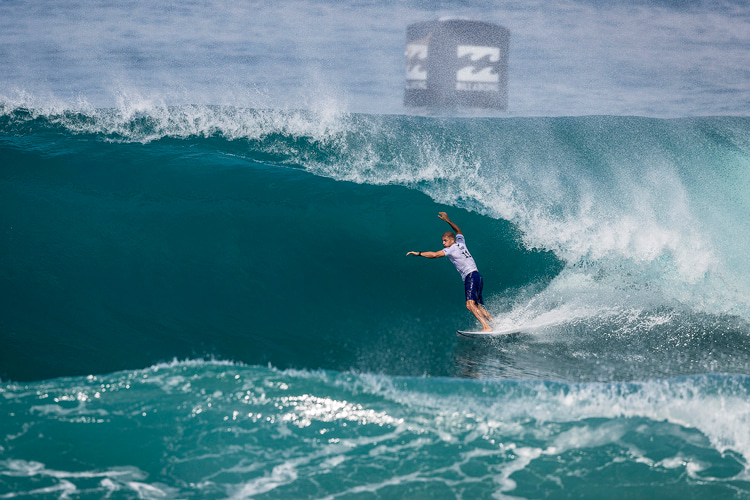
Backdoor is Pipeline's barreling right-hander. It's a super fast, dredging wave with thick walls and falling curtains detonating on even shallower reefs.
It requires surfers to engage with their fins and rails as quickly as possible to increase the chances of a clean exit.
Positioning is critical, and every millisecond counts for your success. It needs a good NE to NW swell to come alive and produce double overhead waves.
Off-The-Wall
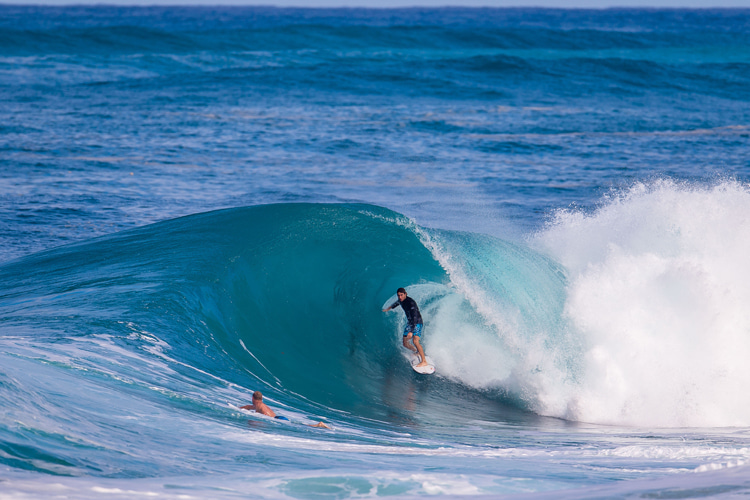
Off-The-Wall earned its designation from a concrete wall facing the spot nearby, but the steep drops witnessed here also contributed.
At this right-hand reef break, angled take-offs are welcome, as well as an extensive backup quiver.
Surfboards are under pressure at the place where Larry Bertlemann rose to glory with his flawless and creative power surfing antics.
OTW can be a great all-around peak for regular footers, mainly with NW and overhead swells.
Rock Piles
Rock Piles is a big wave surf break showcasing a left-hander that starts breaking in deep water when the swell is over ten feet and holds up to triple overhead.
It's a mighty wave, also known as "Gap in the Road," that can roll down the line for 150 yards.
Avoid getting caught inside, or you'll have to deal with the nearby rocky area. It is rarely crowded, especially with powerful NW swells.
Log Cabins
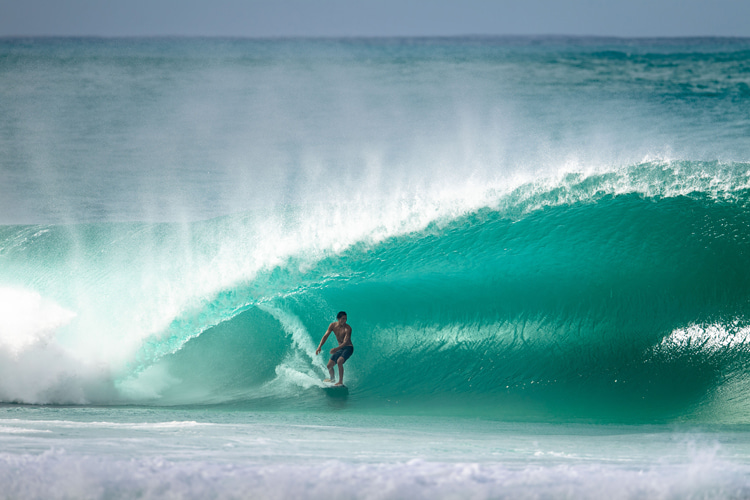
Log Cabins is one of the most famous waves in Hawaii.
On big days, monster waves start to break at Outer Log Cabins before reforming on the inside, closer to the log cabins built on the hillside.
Although primarily a very long right-hander, it also produces a decent left-hander. The ride can be up to 200 yards.
The wave has everything you need to qualify for the advanced surfer certificate - a fast drop-in and fast-moving wall, steep open faces, and a tube section.
Waimea Bay
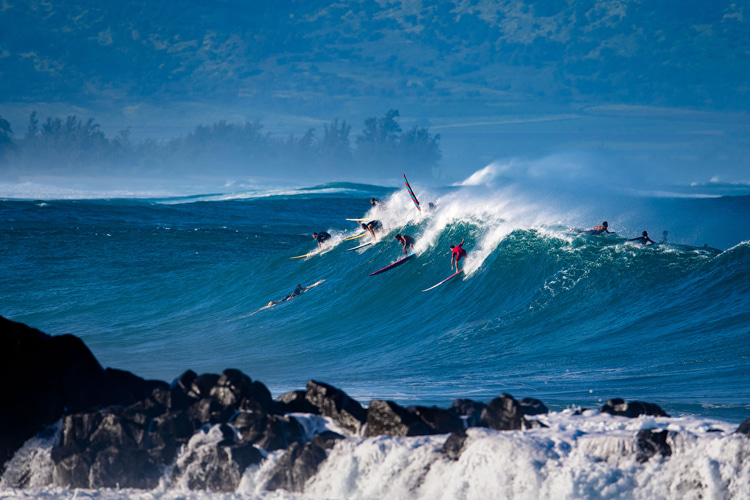
Waimea Bay is a legendary place in Hawaiian and surfing history. The premier big wave surfing break set the stage for a new era in wave riding.
Although it only rarely comes to life with W-NW swells, this is one of the original places where surfers started defying 30-foot-plus giants.
Its unique location also makes it a spectator-friendly coliseum, and it's the historical home of the Eddie Aikau Big Wave Invitational, an event that only runs with maxed-out XXL conditions.
Leftovers
Leftovers is a classic Hawaiian reef break with tricky access, but it is worth trying.
Unlike most North Shore spots, the left-hander requires a high tide to let N swells hit the bottom just right.
The rip currents will require you to check and adjust your position in the lineup constantly. In smaller days, longboards could be an option.
Chun's Reef
Chun's Reef is named after a local 1960s surfer, John Chun.
It's a fun right-hander that is perfect for longboarders wishing to unleash their cross-stepping and nose-riding repertoire on the long, workable walls available.
Chun's Reef is really entertaining when it gets overhead and maintains its perfect-peeling characteristics.
The surf break is home to what was probably North Shore's first surf club, Chun's Reef Surf Society, whose members included Jock Sutherland and Jeff Hakman.
Laniakea
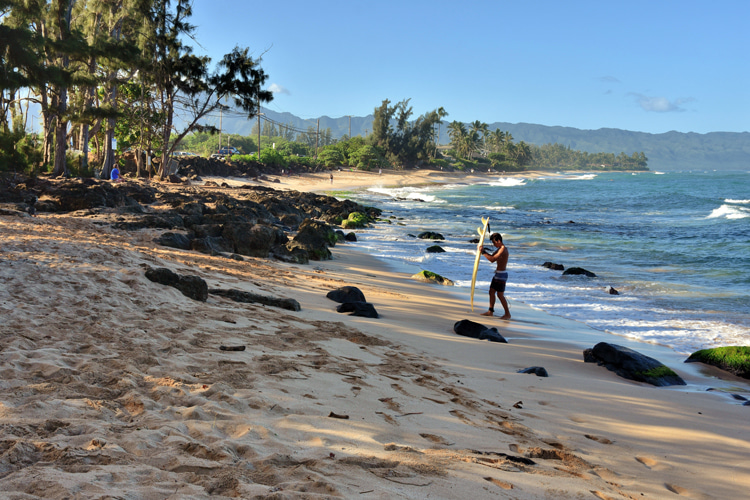
Laniakea is a challenging, very long, and big right-hand wave with a wedgy inside bowl.
The paddle-out is extremely difficult and energy-draining.
But who wouldn't give it a try when the treat on offer is a 400-to-600-yard ride on a bigger NW swell day? Watch out for the freak set.
Haleiwa
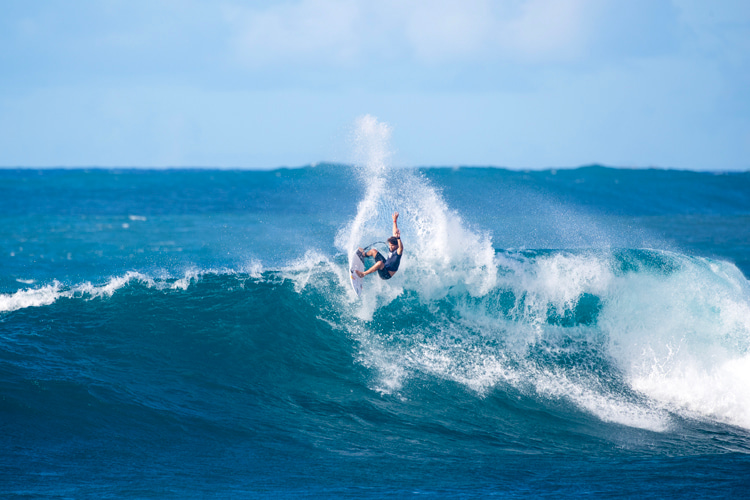
Haleiwa is a perfect right-hand reef break and one of the gems of the Triple Crown of Surfing.
For many, it is also one of the most challenging waves on the North Shore of Oahu, thanks to the powerful rips and the shallow closeout section.
With its sand and coral bottom, the heavy wave has several take-off zones and optimal kick-out areas that you should memorize before initiating a long paddle out the back.
Haleiwa enjoys sizeable NW swells and holds up to 12-foot waves. Locals will make sure (almost) no wave goes unridden.
Mokuleia Beach Park
Mokuleia Beach Park is a two-mile stretch of beach perfectly facing north, thus, totally exposed to the forces of the Pacific Ocean.
Consequently, if you're a surfer, NE trade winds are not welcome here. So, the multiple peaks require WNW and NW swells to come to life.
Make sure to time the lulls and choose your take-off zone wisely in order to maximize fun time in these relatively uncrowded waves.
There are plenty of left and right-handers waiting for you.
